-
收藏模板
- 模板信息
- 更新时间:2023-09-09
- 字数:约19608字
- 页数:约14页
- 格式:.doc
- 推荐版本:Office2016及以上版本
- 售价:5 金币
您可能喜欢的文档
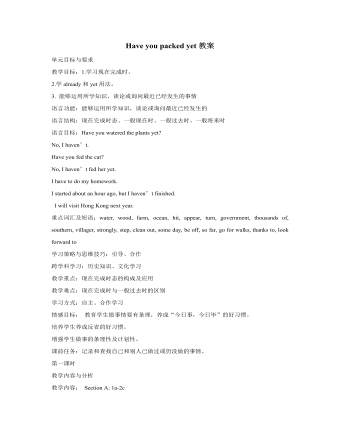
人教版新目标初中英语九年级下册Have you packed yet教案
教学目标:1.学习现在完成时。2.学already和yet用法。3. 能够运用所学知识,谈论或询问最近已经发生的事情语言功能:能够运用所学知识,谈论或询问最近已经发生的语言结构:现在完成时态、一般现在时、一般过去时、一般将来时语言目标:Have you watered the plants yet?No, I haven’t.Have you fed the cat?No, I haven’t fed her yet.I have to do my homework. I started about an hour ago, but I haven’t finished. I will visit Hong Kong next year.重点词汇及短语:water, wood, farm, ocean, hit, appear, turn, government, thousands of, southern, villager, strongly, step, clean out, some day, be off, so far, go for walks, thanks to, look forward to学习策略与思维技巧:引导、合作跨学科学习:历史知识、文化学习教学重点:现在完成时态的构成及应用教学难点:现在完成时与一般过去时的区别 学习方式:自主、合作学习 情感目标: 教育学生做事情要有条理,养成“今日事,今日毕”的好习惯。培养学生养成反省的好习惯。增强学生做事的条理性及计划性。课前任务:记录和查找自己和别人已做过或仍没做的事情。
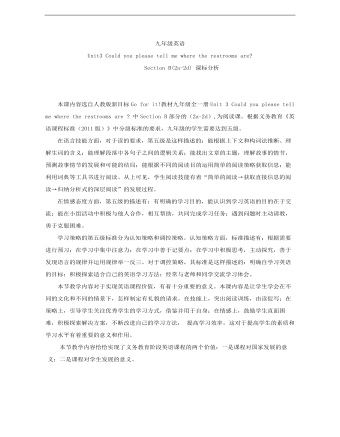
初中英语人教版九年级全册《Unit 3 Could you please tell me where the restrooms are》课标分析说课稿
学习策略的第五级标准分为认知策略和调控策略。认知策略方面,标准描述有:根据需要进行预习;在学习中集中注意力;在学习中善于记要点;在学习中积极思考,主动探究,善于发现语言的规律并运用规律举一反三。对于调控策略,其标准是这样描述的:明确自学习英语的目标;积极探索适合自己的英语学习方法;经常与老师和同学交流学习体会。
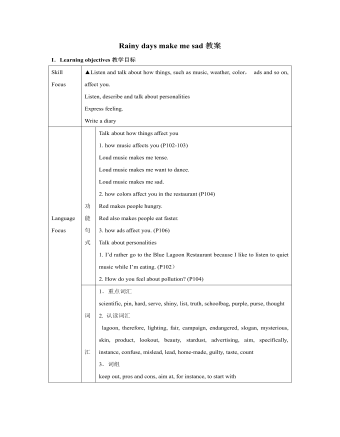
人教版新目标初中英语九年级下册Rainy days make me sad教案
1. 教材分析本单元以how do things affect you?为话题, 从颜色、天气、音乐、广告、产品等方面谈论了外界事物如何影响人的心情。要求学生掌握表达某物或某事给人带来的感觉、看法或影响等。共设计了四个部分的内容:Section A 该部分有4个模块:第一模块围绕Which restaurant would you like to go to?这一话题展开思维(1a)、听力(1b)、口语(1c)训练;第二模块围绕How does music affect you? 进行听力(2a-2b)、口语训练(2c);第三模块继续围绕how do colors in the restaurant affect you这一话题展开训练,训练形式为阅读和问题体验(3a)和小组活动(3b);第四模块仍就How do things affect you这一话题以调查的形式展开讨论。Section B该部分有4个模块:第一模块围绕产品广告对人们的影响这一话题以“配对”(1a)与“列举”(1b)两种形式展开训练;第二模块继续围绕How do things affect you? 进行听力(2a-2b)、口语对话训练(2c);第三模块围绕“Advertising”这一话题展开阅读(3a-3b)和写作(3c)训练;第四模块围绕How posters affect you这一话题以口语训练形式展开小组活动。
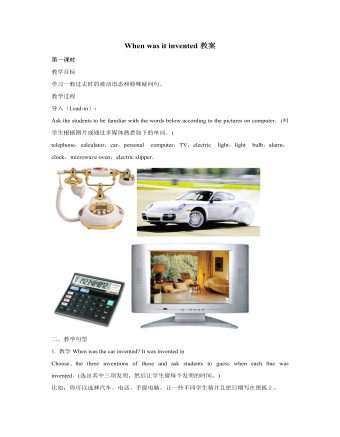
人教版新目标初中英语九年级下册When was it invented教案
二、教学 1a,1b.1.First the teacher asks the students what kind of fruit food and drink you like the best and writes down on the blackboard.教师问学生最喜欢什么水果和饮料并把它们写在黑板上。比如:potato chips,ice cream,tea,lemon,chocolate,oranges,salad,popcorn,pickle and so on.2.接着叫学生表达以上食物的味道,引出新单词——sweet,crispy,salty,sour,delicious,hot,awful,nice…并且完成lb教学内容通过此活动,以旧带新引入新单词。其目的是让学生自主学习新知识。 三、教学 2a,2b1.首先,听力前的brainstormFirst,Let students describe how potato chips taste and describe how helpful the potato chips.Then,ask:When and where were potato chips invented?Who were potato chips invented by?How were potato chips invented?(Let students guess according to the following key words.)Key words:by accident,customer,restaurant,by mistake.(说明:通过问题让学生对对话内容有整体了解,为听力练习做好准备;又培养学生的注意力,想像力,观察力。)
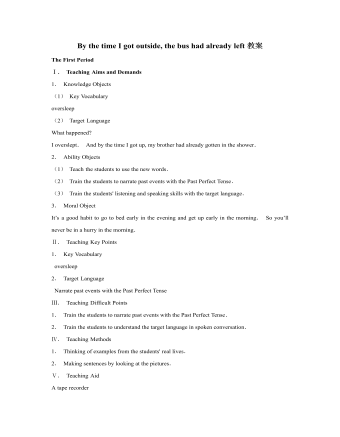
人教版新目标初中英语九年级下册By the time I got outside, the bus had already left教案
Ⅰ. Teaching Aims and Demands1. Knowledge Objects(1) Key Vocabularyoversleep(2) Target LanguageWhat happened?I overslept. And by the time I got up, my brother had already gotten in the shower.2. Ability Objects(1) Teach the students to use the new words.(2) Train the students to narrate past events with the Past Perfect Tense.(3) Train the students' listening and speaking skills with the target language.3. Moral ObjectIt’s a good habit to go to bed early in the evening and get up early in the morning. So you’ll never be in a hurry in the morning.Ⅱ. Teaching Key Points1. Key Vocabularyoversleep2. Target LanguageNarrate past events with the Past Perfect TenseⅢ. Teaching Difficult Points1. Train the students to narrate past events with the Past Perfect Tense.2. Train the students to understand the target language in spoken conversation.Ⅳ. Teaching Methods1. Thinking of examples from the students' real lives.2. Making sentences by looking at the pictures.Ⅴ. Teaching AidA tape recorderⅥ. Teaching ProceduresStep I Revision1. Revise the language points in Unit 8.Ask some questions like this: What volunteer work would you like to do?Help the students to answer, I’d like to…/I love to…/I hope to2. Practice the dialogue in Activity 3c on page 62 again. Get students to role play the similar dialogues with the following.
- 查看更多相关Word文档
Could you please tell me where the restrooms are教案
The First Period
Ⅰ. Teaching Aims and Demands
1. KnowledgeObjects
(1) Key Vocabulary
restroom,shampoo, stamp
(2) Target Language

Excuse me. Can you pleasetell me where I can get a dictionary?
Sure. There’s a bookstoreon River Road.
2. AbilityObjects
(1)Train students listening ability.
(2)Train students communicative competence.
3. Moral Object
Helping each other is very important. It is a goodquality.
Ⅱ. Teaching Key Point
Target Language
Ⅲ. Teaching Difficult Points
1. How to train students listening ability.
2. How to train students communicative competence.
Ⅳ. Teaching Procedures
Step Ⅰ Revision
T: You’re new to thisschool. You need to know where the main office
is.How can you askwhere the main office is?
S1: Where’s themain office?
T: That’s one way toask. But there is a more polite way you can ask. You
can say,"Can you tell me where the main office is?" Class repeat. Can you
tell me wherethe main office is?
Ss: Can youtell me where the main office is?
T: That’s correct. Now let’s say you wantto know where Classroom 1 is.
How can youask?
S2: Can youtell me where Classroom 1 is?
T: Good!There’s another polite way you can ask: Could you tell me how to
get toClassroom 1? Class repeat. Could you tell me how to get to
Classroom 1?
Ss: Could youtell me how to get to Classroom 1?
T: That’s right. Very good.
Step Ⅱ 1a
Go through theinstructions with the class.
Read the listof things to the class. To review the meaning of each item
on the list,invite different students to say each phrase in their own
words.
Point to thelettered parts of the picture one by one.
Ask a student:What kind of place is this?
What do theysell there? Do we have one in our community? What is the name
of the one inour community?
Point out thesample answer. Say, The letter c is in front of the words
buy shampoobecause you could buy shampoo in a department store. There may
be more thanone correct answer for some blanks.
While studentsare working, move around the room offering help as
necessary.
Step Ⅲ 1b
Read theinstructions to students. Point out the two conversations that
are shown inthe picture.
As you listen,fill in the blanks with words you hear in the recording.
Play therecording the first time.Students only listen.
Play therecording a second time.This time ask them to fill in the blanks
with the wordsyou hear.
Check theanswers with the whole class.
Step Ⅳ 1c
Read theinstructions to the class.
Point out thelist of things people need and the pictures of the places in
activity 1a. Say. Look atactivity la. Have a conversation with a partner.
Ask your partner politelywhere you can do these thing and then answer your
partner’s questions.
As studentswork, listen to some pairs in order to check the progress and
help withpronunciation as needed.
After studentshave had a chance to practise several exchanges, ask some
pairs to cometo the front of the classroom and act out their
conversations.
Step Ⅴ Homework
Review thetarget language.
The Second Period
Ⅰ. Teaching Aims and Demands
1. KnowledgeObjects
(1) Key Vocabulary
escalator,furniture, exchange money, elevator
(2) Target Language
Excuse me. Do you knowwhere I can exchange money?
Sure. There’s a bank on thesecond
floor. Take theescalator to the second floor and turn right. The bank is
next to thebookstore.
2. AbilityObjects
(1)Train students listening ability.
(2)Train students communicative competence.
3. Moral Objects
If someone asksyou how to get to the place he wants to go to, you should
tell him theway correctly.
Ⅱ. Teaching Key Points
1. Key Vocabulary
exchange money
2. TargetLanguage
Excuse me. Do you know where I can exchangemoney?
Sure. There’s a bank on the second floor.
3. Structures
Do you know where I can buy shampoo?
Could you tell me how to get to the postoffice?
Can you please tell me where I can get adictionary?
Ⅲ. Teaching Difficult Points
1. Indirectquestions.
2. How to improvestudents listening ability.
Ⅳ.Teaching Procedures
Step Ⅰ Revision
Check homework.
Step Ⅱ 2a
Read theinstructions and point to the list of directions.
Get students toname the items in the picture such as escalator, elevator,
shoe store, andso on.
Play therecording. Students only listen.
Tell them thatthe picture may help them understand what they are hearing.
Play therecording again. This time ask students to write a number next to
four of thedirections.
Check theanswers with the whole class.
Step Ⅲ 2b
Point to thepicture. Say, now you will hear the recording again. This
time show wherethe boy went as he followed the directions to the drug
store. Draw a line onthe picture in your book.
Play therecording again and ask students to draw the line on their own.
Check theanswer with the class.
Step Ⅳ 2c
Ask a pair ofstudents to read the sample conversation aloud to the class.
Read theinstructions aloud. Say. Make conversations using information
about theplaces in the picture with your partners.
As studentswork, move around the classroom checking the progress of the
pairs andoffering help as needed.
Ask one or twopairs to say their conversations to the class. Ask the rest
of the class tolook at the picture as they listen.
Step Ⅴ Homework
Ask thestudents to write three sentences with the starters of the
structures.
The Third Period
Ⅰ. Teaching Aims and Demands
1. KnowledgeObjects
(1) Key Vocabulary
hang out,fresh, advantage, disadvantage, block
(2)Target Language
Go out thefront door and take a right. Walk about three blocks. Go past
the park, andturn left onto Oak Street.
3. Moral Objects
Anything hasboth advantages and disadvantages. We should treat everything
correctly.
Ⅱ. Teaching Key Point
Train students listening, speaking, reading and writing ability.
Ⅲ. Teaching Difficult Points
How to improve students integrating skills.
Ⅳ. Teaching Procedures
Step Ⅰ Revision
T: Yesterday welearned the structures.
Do you knowwhere…? Could you tell me how to get to…? Can you please tell
me where…? Nowwho can make sentences by using the structures?
Step Ⅱ 3a
Read theinstructions. Point out the blank lines under the words
Advantages andDisadvantages below the interview.
You will writeyour answers in these blanks.
Read the firsttwo sentences at the top of the article.
Explain thatthe interviewer will talk to several teenagers.
Get students toread the interview on their own quickly.
When they havefinished, ask if there are any words or sentences they don’t understand. If there are,explain them.
Ask students toread the interview again and write the advantages and disadvantages. Check theanswers with the whole class.
Step Ⅲ 3b
Read theinstructions. Point out the conversation in the box and invite two students toread it to the class.
Point out thelist of advantages and disadvantages in Activity 3a. Say,
You can usethese items and any other items you can think of as you talk about places youusually hang out.
Ask students towork in groups of four or five. As they work, move around the classroom helping the groups asnecessary. Make sure they talk about both advantages and disadvantages.
Ask severalgroups to act out part of their conversation to the class.
Step Ⅳ 4
Read theinstructions to the class. Get students to look back at the picture and activities on thefirst page of this unit.
Point out thesample language in the box. Invite a student to read it to the class.
Ask students tosay the names of some stores and other places in the community and write themon the board. Say,
Each group canchoose three of these places to write about, or you can choose another placeyou know ofWrite careful directions from the school to each place, but donot say the name of the place. You can use the words this place instead. In order to helpstudents work, draw a simple map showing the school and several nearby streets.
When the groupsare ready, they read their directions to the class and the other students guessthe name of the place they are talking about.
Step Ⅴ Homework
1. Ask studentsto choose two places in the community and write careful directions from theschool to each place.
2. Finish off theexercises on pages 46~47 of the workbook.
The Fourth Period
Ⅰ. Teaching Aims and Demands
1. KnowledgeObjects
(1)Key Vocabulary
fascinating,convenient, safe, restroom, inexpensive
(2)Target Language
Can you tell mewhere there’s a good place to eat?
Of course. What kind offood do you like?
2. AbilityObjects
(1) Train students writing and speaking ability.
(2) Train students ability to understand the targetlanguage in spoken conversation.
(3) Train students ability to use the target language.
Ⅱ. Teaching Key Points
1. Key Vocabulary
convenient, safe, restroom inexpensive
2. TargetLanguage
Can you tell me where there’s a good place toeat?
Of course. What kind of food do you like?
Ⅲ. Teaching Difficult Points
1. How to improvestudents writing and speaking ability.
2. How to use thetarget language.
Ⅳ. Teaching Procedures
Step Ⅰ Revision
Check homework.
Step Ⅱ 1a
Go through theinstructions with the class.
Read the wordsin the box to the class and ask if there are any of these words that studentsdon’t understand. If so, help students to explain the meaning of the word.
Then read theinstructions again and point out the sample answer. Get a studentto read the sample answer to the class. Point out that students can also writeother words after the word clean.
Ask students towrite words from the box in the blanks on their own. Help studentsif needed.
Correct theanswers by having students read what qualities he or she listed.
Step Ⅲ 1b
Read the instructionsto the class.
Point out theexample in the box. Invite two students to read it to the class.
Now work with apartner. Look at the words in the box and use them to talk about places inyour own city. As students talk, move around the classroom checking their work. Offer languagesupport as needed.
Invite severalpairs of students to say their conversations to the class.
Step Ⅳ 2a
Point to thepicture and ask students to tell what is happening. If necessary,explain that the scene shows a family on vacation. They are asking the man forinformation about various things to do in Sunville.
Go through theinstructions and point to the chart.
Play therecording. Students only listen the first time.
Play therecording again. Ask students to write the places people ask about.
Check theanswers with the whole class.
Step Ⅴ 2b
Read theinstructions and point to the chart.You will hear the same recording again.
This timelisten carefully to the answers the clock gives. Write the answers in the blanks alone.Point out thesample answer.Play the recording again. Ask students to write their answers inthe blanks.Check the answers.
Step Ⅵ 2c
Point to thesample conversation. Invite two students to read it to the class.Read theinstructions. Role play the conversations you hear on the tape.Get students towork in pairs. Move around the room checking the progress of the pairs andoffering help as needed.
Ask one or twopairs to say their conversations to the class.
Step ⅦHomework
Talk about someplaces using the words in la, then write down the conversations.
The FifthPeriod
Ⅰ. Teaching Aims and Demands
1. Knowledge Objects
(1) Key Vocabulary
water slide,clown, dress up, have fun
(2) Practise reading an article.
(3) Practise writing something using thetarget language.
2. AbilityObjects
(1) Train students reading ability.
(2) Train students writing ability.
Ⅱ. Teaching Key Point
Practisereading and writing using the target language.
Ⅲ. Teaching Difficult Point
How to write aguide to a place.
Ⅳ. Teaching Procedures
Step I Revision
Review thetarget language presented in this unit. Check homework.
Step Ⅱ 3a
Invite a studentto read the article aloud to the class. Correct any pronunciation errors tomake sure the student is providing a good model for the rest of the class.
Ask students toread the article again and complete the chart. Get students to do the work on theirown or in pairs. As they work, move around the classroom and offer help asnecessary. Check the answers.
Step m 3b
Read theinstructions to the class. Point to the first two sentences and ask a student to readthese sentences to the class.
Look back at Activities2a and 2b. Use this information to help you complete the guide to Sunville.
Ask thestudents to complete the brochure on their own. As they work, walk around theclassroom offering help and answering questions as needed.Invite astudent to read the completed article to the class.
Step Ⅳ 3c
Read theinstructions to the class.Ask students to say the names of some of the places they mightwrite about. Write a list of these places on the board forstudents to use as they write their guides.Ask students to work on their own. Tell them thatthey can use what they wrote
for activity 3bas a guide. They can write the guide for all tourists, teenagers, families,or people on a budget. As they work, move around the room offering help as needed. Correct the students work. Ask some students to read their guides and correct them.
Step Ⅴ Part 4
Go through theinstructions with the class.Get students to look back at the guides they wrote in Activity3c.Ask students to work in groups of four or five students. Let differentstudents play the role of the booth worker and the different tourists. Make sureevery student has a chance to participate.Ask one or two groups to say one oftheir conversations to the class.
Step Ⅵ Homework
1. Read thearticle in 3a again.
2. Write a guideto our city.
The Sixth Period
Ⅰ. Teaching Aims and Demands
1. KnowledgeObjects
(1) Fill in blanks and make sentencesusing beautiful, safe, delicious, convenient, fascinating.
(2)Write some questions using the targetlanguage.
2. Ability Objects
Train students writing ability.
Ⅱ. Teaching Key Points
1. Fill in blanksand make sentences.
2. Writequestions using the target language.
Ⅲ. Teaching Difficult Point
Make sentencesusing "beautiful, safe, delicious, convenient, fascinating".
Ⅳ.Teaching Procedures
转载请注明出处!本文地址:
https://www.lfppt.com/worddetails_10378155.html最新课件教案文档
-
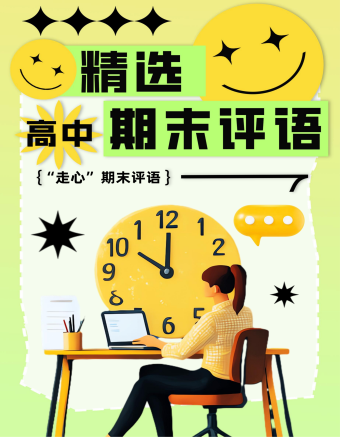
精选高中生期末评语
1、该生学习态度端正 ,能够积极配合老师 ,善于调动课堂气氛。 能够积极完成老师布置的任务。学习劲头足,听课又专注 ,做事更认 真 ,你是同学们学习的榜样。但是,成绩只代表昨天,并不能说明你 明天就一定也很优秀。所以,每个人都应该把成绩当作自己腾飞的起 点。2、 你不爱说话 ,但勤奋好学,诚实可爱;你做事踏实、认真、为 人忠厚 ,是一个品行端正、有上进心、有良好的道德修养的好学生。在学习上,积极、主动,能按时完成老师布置的作业,经过努力 ,各 科成绩都有明显进步,你有较强的思维能力和学习领悟力,学习也有 计划性,但在老师看来,你的潜力还没有完全发挥出来,学习上还要有持久的恒心和顽强的毅力。
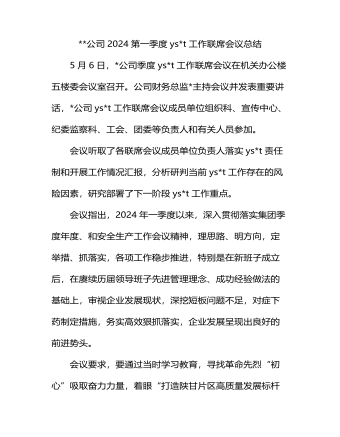
公司2024第一季度意识形态工作联席会议总结
一是要把好正确导向。严格落实主体责任,逐条逐项细化任务,层层传导压力。要抓实思想引领,把理论学习贯穿始终,全身心投入主题教育当中;把理论学习、调查研究、推动发展、检视整改等有机融合、一体推进;坚持学思用贯通、知信行统一,努力在以学铸魂、以学增智、以学正风、以学促干方面取得实实在在的成效。更加深刻领会到******主义思想的科学体系、核心要义、实践要求,进一步坚定了理想信念,锤炼了政治品格,增强了工作本领,要自觉运用的创新理论研究新情况、解决新问题,为西北矿业高质量发展作出贡献。二是要加强应急处事能力。认真组织开展好各类理论宣讲和文化活动,发挥好基层ys*t阵地作用,加强分析预警和应对处置能力,提高发现力、研判力、处置力,起到稳定和引导作用。要坚决唱响主旋律,为“打造陕甘片区高质量发展标杆矿井”、建设“七个一流”能源集团和“精优智特”新淄矿营造良好的舆论氛围。三是加强舆情的搜集及应对。加强职工群众热点问题的舆论引导,做好舆情的收集、分析和研判,把握时、度、效,重视网上和网下舆情应对。
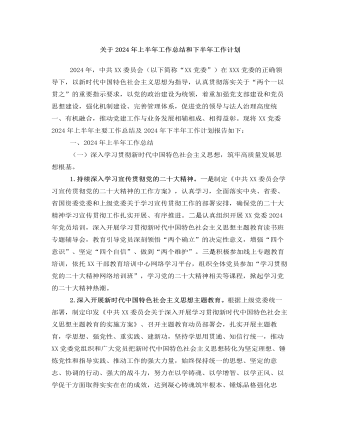
关于2024年上半年工作总结和下半年工作计划
二是深耕意识形态。加强意识形态、网络舆论阵地建设和管理,把握重大时间节点,科学分析研判意识形态领域情况,旗帜鲜明反对和抵制各种错误观点,有效防范处置风险隐患。积极响应和高效落实上级党委的决策部署,确保执行不偏向、不变通、不走样。(二)全面深化党的组织建设,锻造坚强有力的基层党组织。一是提高基层党组织建设力量。压实党建责任,从政治高度检视分析党建工作短板弱项,有针对性提出改进工作的思路和办法。持续优化党建考核评价体系。二是纵深推进基层党建,打造坚强战斗堡垒。创新实施党建工作模式,继续打造党建品牌,抓实“五强五化”党组织创建,广泛开展党员教育学习活动,以实际行动推动党建工作和经营发展目标同向、部署同步、工作同力。三是加强高素质专业化党员队伍管理。配齐配强支部党务工作者,把党务工作岗位作为培养锻炼干部的重要平台。
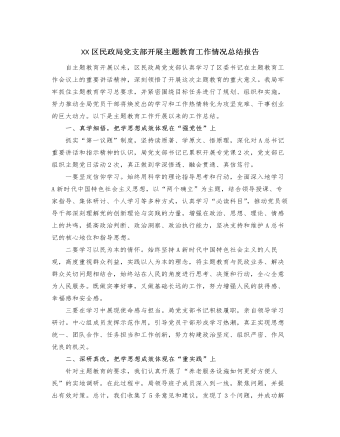
XX区民政局党支部开展主题教育工作情况总结报告
二要专注于解决问题。根据市委促进经济转型的总要求,聚焦“四个经济”和“双中心”的建设,深入了解基层科技工作、学术交流、组织建设等方面的实际情况,全面了解群众的真实需求,解决相关问题,并针对科技工作中存在的问题,采取实际措施,推动问题的实际解决。三要专注于急难愁盼问题。优化“民声热线”,推动解决一系列基层民生问题,努力将“民声热线”打造成主题教育的关键工具和展示平台。目前,“民声热线”已回应了群众的8个政策问题,并成功解决其中7个问题,真正使人民群众感受到了实质性的变化和效果。接下来,我局将继续深入学习主题教育的精神,借鉴其他单位的优秀经验和方法,以更高的要求、更严格的纪律、更实际的措施和更好的成果,不断深化主题教育的实施,展现新的风貌和活力。
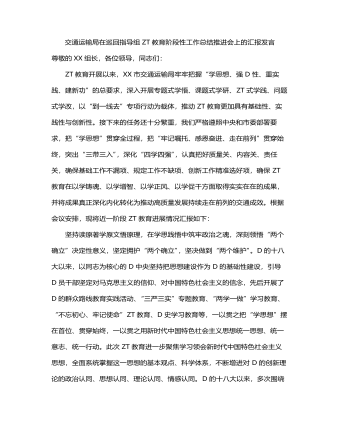
交通运输局在巡回指导组主题教育阶段性工作总结推进会上的汇报发言
今年3月,市政府出台《关于加快打造更具特色的“水运XX”的意见》,提出到2025年,“苏南运河全线达到准二级,实现2000吨级舶全天候畅行”。作为“水运XX”建设首战,谏壁闸一线闸扩容工程开工在即,但项目开工前还有许多实际问题亟需解决。结合“到一线去”专项行动,我们深入到谏壁闸一线,详细了解工程前期进展,实地察看谏壁闸周边环境和舶通航情况,不断完善施工设计方案。牢牢把握高质量发展这个首要任务,在学思践悟中开创建功之业,坚定扛起“走在前、挑大梁、多做贡献”的交通责任,奋力推动交通运输高质量发展持续走在前列。以学促干建新功,关键在推动高质量发展持续走在前列。新时代中国特色社会主义思想着重强调立足新发展阶段、贯彻新发展理念、构建新发展格局,推动高质量发展,提出了新发展阶段我国经济高质量发展要坚持的主线、重大战略目标、工作总基调和方法论等,深刻体现了这一思想的重要实践价值。
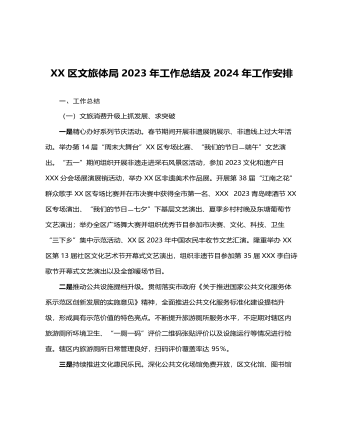
XX区文旅体局2023年工作总结 及2024年工作安排
三、2024年工作计划一是完善基层公共文化服务管理标准化模式,持续在公共文化服务精准化上探索创新,围绕群众需求,不断调整公共文化服务内容和形式,提升群众满意度。推进乡镇(街道)“114861”工程和农村文化“121616”工程,加大已开展活动的上传力度,确保年度目标任务按时保质保量完成。服务“双减”政策,持续做好校外培训机构审批工作,结合我区工作实际和文旅资源优势,进一步丰富我市义务教育阶段学生“双减”后的课外文化生活,推动“双减”政策走深走实。二是结合文旅产业融合发展示范区,全力推进全域旅游示范区创建,严格按照《国家全域旅游示范区验收标准》要求,极推动旅游产品全域布局、旅游要素全域配置、旅游设施全域优化、旅游产业全域覆盖。
今日更新Word
-

精选高中生期末评语
1、该生学习态度端正 ,能够积极配合老师 ,善于调动课堂气氛。 能够积极完成老师布置的任务。学习劲头足,听课又专注 ,做事更认 真 ,你是同学们学习的榜样。但是,成绩只代表昨天,并不能说明你 明天就一定也很优秀。所以,每个人都应该把成绩当作自己腾飞的起 点。2、 你不爱说话 ,但勤奋好学,诚实可爱;你做事踏实、认真、为 人忠厚 ,是一个品行端正、有上进心、有良好的道德修养的好学生。在学习上,积极、主动,能按时完成老师布置的作业,经过努力 ,各 科成绩都有明显进步,你有较强的思维能力和学习领悟力,学习也有 计划性,但在老师看来,你的潜力还没有完全发挥出来,学习上还要有持久的恒心和顽强的毅力。
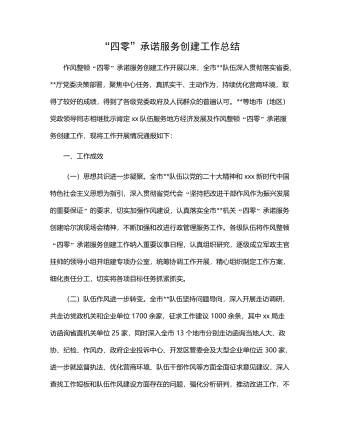
“四零”承诺服务创建工作总结
(二)坚持问题导向,持续改进工作。要继续在提高工作效率和服务质量上下功夫,积极学习借鉴其他部门及xx关于“四零”承诺服务创建工作的先进经验,同时主动查找并着力解决困扰企业和群众办事创业的难点问题。要进一步探索创新,继续优化工作流程,精简审批程序,缩短办事路径,压缩办理时限,深化政务公开,努力为企业当好“保姆”,为群众提供便利,不断适应新时代人民群众对政务服务的新需求。(三)深化内外宣传,树立良好形象。要深入挖掘并及时总结作风整顿“四零”承诺服务创建工作中形成的典型经验做法,进一步强化内部宣传与工作交流,推动全市创建工作质效整体提升。要面向社会和公众庄严承诺并积极践诺,主动接受监督,同时要依托电台、电视台、报纸及微信、微博等各类媒体大力宣传xx队伍作风整顿“四零”承诺服务创建工作成果,不断扩大社会知情面和群众知晓率。
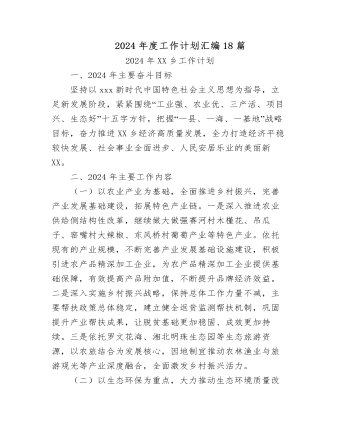
2024年度工作计划汇编(18篇)
1.市政基础设施项目5项,总建设里程2.13km,投资概算2.28亿元。其中,烔炀大道(涉铁)工程施工单位已进场,项目部基本建成,正在办理临时用地、用电及用水等相关工作;中铁佰和佰乐(巢湖)二期10KV外线工程已签订施工合同;黄麓镇健康路、纬四路新建工程均已完成清单初稿编制,亟需黄麓镇完成图审工作和健康路新建工程的前期证件办理;公安学院配套道路项目在黄麓镇完成围墙建设后即可进场施工。2.公益性建设项目6项,总建筑面积15.62万㎡,投资概算10.41亿元。其中,居巢区职业教育中心新建工程、巢湖市世纪新都小学扩建工程已完成施工、监理招标挂网,2月上旬完成全部招标工作;合肥职业技术学院大维修三期已完成招标工作,近期签订施工合同后组织进场施工;半汤疗养院净化和医用气体工程已完成招标工作;半汤疗养院智能化工程因投诉暂时中止;巢湖市中医院(中西医结合医院)新建工程正在按照既定计划推进,预计4月中下旬挂网招标。

驻村工作队2024年第一季度工作总结汇编(4篇)
三是做大做强海产品自主品牌。工作队于xx年指导成立的冬松村海产品合作社,通过与消费帮扶平台合作,在工作队各派出单位、社会团体、个人支持下,已获得逾xx万元销售额。2022年底工作队推动合作社海产品加工点扩建的工作方案已获批,待资金下拨后将正式启动扩建工作。四是积极助企纾困,带动群众增收致富。工作队利用去年建立的xx镇产业发展工作群,收集本地企业在产品销售、技术、人力、资金、运营、用地等方面的需求,并加大xx支持乡村振兴力度,xx助理赴各村委开展多场xx政策支持乡村振兴宣讲活动,本季度有x万元助农贷款获批,xx万贷款正在审批中。在壮大既有产业的同时,完善联农带农机制,一方面鼓励企业雇用本地农户就业,另一方面计划与本地农户签订长期收购合同,让农民种得放心、种得安心,带动当地群众共同致富。

主题教育总结常用提纲大全
第一,主题教育是一次思想作风的深刻洗礼,初心传统进一步得到回归。第二,主题教育是一次沉疴积弊的集中清扫,突出问题进一步得到整治。第三,主题教育是一次强化为民服务的生动实践,赤子之情进一步得到提振。第四,主题教育是一次激发创业担当的有利契机,发展层次进一步得到提升。2.第一,必须提领思想、武装思想。第二,必须聚焦问题、由表及里。第三,必须领导带头、以上率下。第四,必须务实求实、认真较真。3.一是抬高政治站位,坚持大事大抓。二是坚持思想领先,狠抓学习教育。三是突出问题导向,深入整改纠治。四是坚持领导带头,发挥表率作用。4.一是立足“早”字抓筹划。二是着眼“活”字抓学习。三是围绕“统”字抓协调。5.一是形势所需。二是任务所系。三是职责所在。四是制度所定。6.一要提升认识。二要积极作为。三要密切协作。
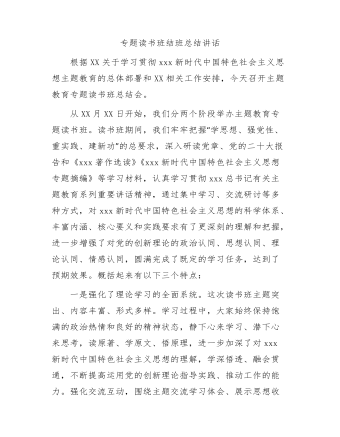
主题教育专题读书班结班总结讲话
第二,要把调查研究贯穿始终,实干担当促进发展。开展好“察实情、出实招”“破难题、促发展”“办实事、解民忧”专项行动,以强化理论学习指导发展实践,以深化调查研究推动解决发展难题。领导班子成员要每人牵头XX个课题开展调查研究,XX月底前召开调研成果交流会,集思广益研究对策措施。各部门、各单位要制定调研计划,通过座谈访谈、问卷调查、统计分析等方式开展调查研究,解决工作实际问题,帮助基层单位和客户解决实际困难。第三,要把检视问题贯穿始终,廉洁奉公树立新风。认真落实公司主题教育整改整治工作方案要求,坚持边学习、边对照、边检视、边整改,对标对表xxx新时代中国特色社会主义思想,深入查摆不足,系统梳理调查研究发现的问题、推动发展遇到的问题、群众反映强烈的问题,结合巡视巡察、审计和内外部监督检查发现的问题,形成问题清单。

















